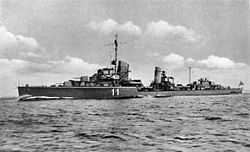Z 4 Richard Beitzen
|
Z 4 Richard Beitzen
|
||||||||||||||||||
|
||||||||||||||||||
|
||||||||||||||||||
|
||||||||||||||||||
|
||||||||||||||||||
Z 4 Richard Beitzen was one of four destroyers of the destroyer class 1934 of the German Navy during World War II . The boat was named after the lieutenant captain Richard Beitzen , who fell as chief of the 14th torpedo boat semi-flotilla in the First World War . Commissioned in 1937, the Richard Beitzen was used throughout the war, was awarded to Great Britain after the war and finally scrapped in 1947.
history
Pre-war period
On July 17, 1939, Z 4 was in poor visibility in the roadstead of Wilhelmshaven and was rammed at the stern by the fleet attendant F 7 . The damage was repaired a month later.
War missions
Z 4 Richard Beitzen carried out numerous mining operations in the North Sea off the British coast at the start of the war . On 22./23. In February 1940, the Richard Beitzen came as part of the 1st destroyer flotilla in the association of the FdZ (Commodore Bonte ) with five other destroyers in the company Wikinger against British fish steamers in the North Sea. He 111 of II./ KG 26 erroneously attacked the marching destroyers and scored three bomb hits on the Leberecht Maass . During their evasive maneuvers, the Leberecht Maass and the Max Schultz got into a British mine lock and sank after being hit by mines . Only 60 men from Leberecht Maass could be saved, none of them survived the sinking of Max Schultz . A total of 578 crew members lost their lives.
The Richard Beitzen was then moved to Brest in France, where it arrived on October 22, 1940. From Brest, Z 4 participated in companies in the Bay of Biscay and the English Channel . On March 16, 1941, the Z 4 was ordered back to Kiel to be overtaken. From there, the destroyer was moved to Kirkenes in Norway in July 1941 and was then involved in the attack on the Soviet occupation of the island of Kildin . Z 4 escorted the battleship Tirpitz to Norway in January 1942 . On January 25, 1942, the crew of Z 4 188 rescued survivors of the destroyer Z 8 Bruno Heinemann , who had run into a mine while marching to France.
In February 1942, supported Z 4 in the firm Cerberus channel breakthrough of battleships Scharnhorst , Gneisenau and the heavy cruiser Prinz Eugen , began with the Prinz Eugen on companies Sports Palace part and was then used to January 1943 in the waters off Norway. By October 1943, Z 4 was overhauled in Kiel for several months, but on October 27 the boat was damaged by a grounding and had to be repaired again.
Z 4 carried out escort duties until shortly before the end of the war , until it was badly damaged on April 24, 1945 by an aerial bomb hit close to it . The destroyer entered the port of Oslo at 15 knots , where the crew learned of the German surrender on May 9, 1945.
After the war
The Richard Beitzen went to Great Britain as spoils of war on January 15, 1946. The boat was given the identification number H 97 for tests . In 1946 it had to be put on because of a rotten ship floor. H 97 was taken out of service in 1947 and scrapped from January 10, 1949.
Commanders
- Corvette Captain Hans-Joachim Gadow : from commissioning to May 1938
- Corvette Captain Moritz Schmidt: from May 1938 to November 1939
- Frigate Captain Hans von Davidson: from November 1939 to January 1943
- Frigate Captain Hans Dominik : from January 1943 to January 1944
- unoccupied
- Captain Walter Lüdde-Neurath (i. V.): from April 1944 to June 1944
- Corvette Captain Rudolf Gade: from June 1944 to September 1944
- Frigate Captain Helmut Neuss : from September 1944 until the end of the war
literature
- Heinz Ciupa: The German warships 1939-1945 , VPM, ISBN 3-8118-1409-5 .
- Hans H. Hildebrand, Albert Röhr, Hans-Otto Steinmetz: The German Warships - Biographies , Volume 7.
- Gerhard Koop, Klaus-Peter Schmolke: German Destroyers of World War II - Warships of the Kriegsmarine . Seaforth Publishing, 2014, p. 80 ff.
Individual evidence
- ↑ Jürgen Rohwer , Gerhard Hümmelchen : Chronik des Maritime War 1939–1945, February 1940. Retrieved on January 24, 2017 .
- ↑ Harald Fock: Z-before! International development and war missions of destroyers and torpedo boats. Volume 2: During World War II: 1940-1945. Koehlers Verlagsgesellschaft, Hamburg 2001, ISBN 3-7822-0762-9 , p. 120
Remarks
- ↑ The former Kriegsmarine referred to all vehicles up to and including destroyer size as boats, regardless of the fact that they were mostly ships. See: boat / ship
